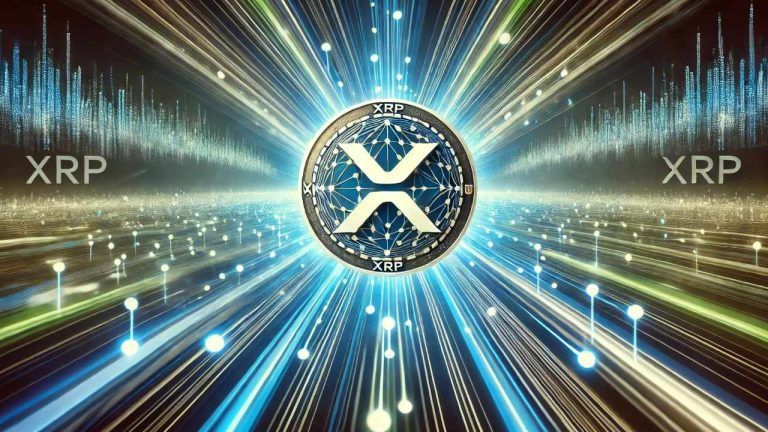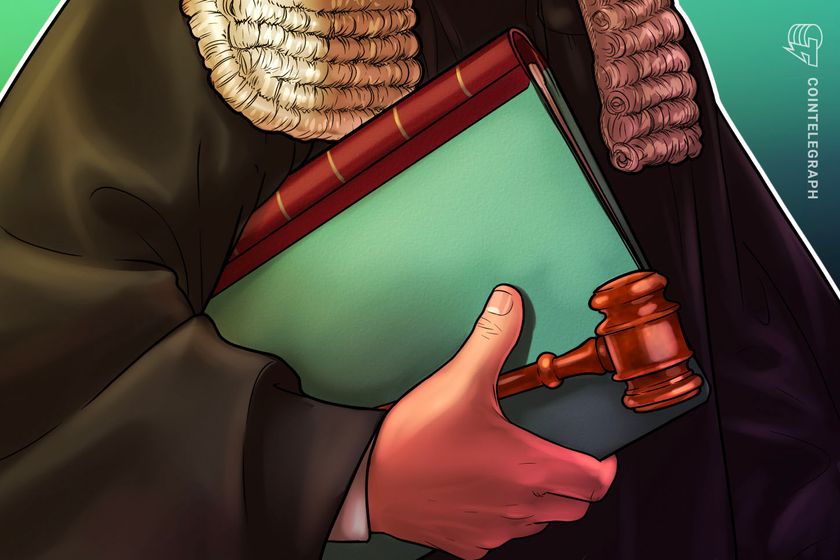 Asset management firm Bitwise has filed for a spot XRP exchange-traded fund (ETF) with the Delaware Division of Corporations. While this does not confirm an immediate filing with the U.S. Securities and Exchange Commission (SEC), it aligns with Ripple CEO Brad Garlinghouse’s positive outlook on the future of XRP ETFs. Bitwise’s Move Toward an XRP […]
Asset management firm Bitwise has filed for a spot XRP exchange-traded fund (ETF) with the Delaware Division of Corporations. While this does not confirm an immediate filing with the U.S. Securities and Exchange Commission (SEC), it aligns with Ripple CEO Brad Garlinghouse’s positive outlook on the future of XRP ETFs. Bitwise’s Move Toward an XRP […]

The crypto-focused asset manager filed the exchange-traded fund application in the state of Delaware.
An application for a Bitwise XRP exchange-traded fund (ETF) has appeared on the State of Delaware’s Division of Corporations website. Cointelegraph independently confirmed the filing with a Bitwise spokesperson.
According to the filing, the Bitwise XRP ETF was incorporated on Sept. 30, 2024. The registered agent was listed as CSC Delaware Trust Company, which is headquartered in Wilmington, Delaware.
The application comes just a few months after Ripple’s CEO, Brad Garlinghouse, hinted about the upcoming financial product, describing an XRP ETF as “inevitable” following the launch of Bitcoin and Ether ETFs in the United States.
 Terraform Labs has received court approval to wind down operations in bankruptcy following a settlement with the U.S. Securities and Exchange Commission (SEC). The company had been at the center of a scandal that left cryptocurrency investors facing significant losses after the Terra ecosystem collapsed. Court Approves Terraform Labs Wind-Down Terraform Labs has been granted […]
Terraform Labs has received court approval to wind down operations in bankruptcy following a settlement with the U.S. Securities and Exchange Commission (SEC). The company had been at the center of a scandal that left cryptocurrency investors facing significant losses after the Terra ecosystem collapsed. Court Approves Terraform Labs Wind-Down Terraform Labs has been granted […]

The parent company of Silvergate Bank has listed assets ranging from $100 million to $500 million and liabilities between $10 million and $50 million.
Silvergate Capital Corporation, the parent company of Silvergate Bank, filed for Chapter 11 bankruptcy in the US Bankruptcy Court for the District of Delaware.
According to a filing on Sept. 17, the company has listed assets between $100 million and $500 million and liabilities ranging from $10 million to $50 million. The bankruptcy petition includes Silvergate’s two affiliates, Silvergate Liquidation Corporation and Spring Valley Lots, LLC.
Silvergate’s reorganization plan, filed as part of its Chapter 11 bankruptcy, proposes fully paying several types of debts, including administrative fees, taxes, and other high-priority claims like secured loans and professional fees.

Shareholders accused Tesla boss Elon Musk of “brazen disloyalty” with his xAI startup that created “billions in AI-related value at a company other than Tesla.”
Tesla shareholders sued CEO Elon Musk and the vehicle maker’s board on Thursday, claiming Musk’s xAI startup is a “competing company” taking artificial intelligence talent and resources from the firm.
It comes the same day shareholders voted to restore Musk’s $44.9 billion pay package that a Delaware judge threw out in January.
Cleveland Bakers and Teamsters Pension Fund, Daniel Hazen and Michael Giampietro filed the June 13 stockholder complaint in Delaware’s Chancery Court on behalf of Tesla.

After being dismissed by the Delaware Court of Chancery in 2023, the state’s supreme court ruled the definition of the merger agreement between BitGo and Galaxy was “ambiguous.”
Delaware’s Supreme Court has reversed a ruling from a lower court that dismissed a $100 million lawsuit brought by BitGo against Galaxy Digital following a failed acquisition.
In a May 22 filing, the Supreme Court of the State of Delaware said language in the BitGo-Galaxy Digital $1.2 billion merger agreement — which the latter terminated in August 2022 — was “ambiguous.” The state supreme court concluded that it would reverse the Delaware Chancery Court’s decision “for the consideration of such extrinsic evidence as may be appropriate to resolve this ambiguity.”
The successful appeal, first submitted on Feb. 7, would seemingly allow BitGo another bite at the apple to file suit against Galaxy Digital. In an August 2022 lawsuit, the firm alleged Galaxy committed an “intentional breach” of the acquisition agreement. Galaxy claimed at the time that it was within its rights to drop the deal after BitGo failed to deliver audited financial statements from 2021.

The largest investment firm in the world is filing for a spot market Ethereum (ETH) exchange-traded fund (ETF) with the U.S. Securities and Exchange Commission (SEC) months after applying for a spot Bitcoin (BTC) ETF. In a new filing, BlackRock – which has over $8 trillion in assets under its management – is seeking the […]
The post BlackRock Files for a Spot Ethereum ETF With the SEC Months After Applying for a Similar Bitcoin Product appeared first on The Daily Hodl.

State authorities may be investigating the fake registration for a BlackRock “iShares XRP Trust” following a referral from Delaware's Division of Corporations.
A fake filing published to the State of Delaware’s Division of Corporations on Nov. 13 will be referred to the Delaware Department of Justice.
In a Nov. 14 statement, a spokesperson for the Delaware Department of State told Cointelegraph that the false filing claiming that asset manager BlackRock registered an “iShares XRP Trust” would be referred to state authorities. The registration, which appeared as a listing on the state’s Division of Corporations on Nov. 13, momentarily caused the price of XRP to surge roughly 12% before losing its gains when the falsehood was revealed.
This is a developing story, and further information will be added as it becomes available.

XRP’s price surge was short-lived and has almost returned to its original price.
A BlackRock filing suggesting the asset manager was creating an XRP (XRP) exchange-traded product caused a 12% spike in XRP, which it quickly lost after the filing was confirmed as fake.
The saga lasted an hour late on Nov. 14 as X (Twitter) users picked up on a Delaware filing showing BlackRock filed to register the “iShares XRP Trust” — a precursor to launching an exchange-traded fund (ETF).
XRP gained 12%, spiking to $0.73 within 30 minutes of the news of the filing. However, it lost all its gains in half an hour after it was confirmed a fake by Bloomberg ETF analyst Eric Balchunas, who spoke with BlackRock.

Balchunas speculated someone listed the XRP trust on the Delaware list of corporations website by impersonating BlackRock managing director Daniel Schwieger.
This is false! Confirmed by BlackRock by me. Some whacko must have added using BlackRock executive name etc. Cmon man. pic.twitter.com/cDpnycYwjQ
— Eric Balchunas (@EricBalchunas) November 13, 2023
Bitcoin Magazine analyst Dylan LeClair was one of the first to initially break the news. Balchunas and The Block also shared news of the listing on X in now-deleted pos.
Related: Ripple faces slim odds of $770M disgorgement — XRP holders attorney
BlackRock signaled its intention to expand beyond Bitcoin with its ETF aspirations after the firm filed for a spot Ether ETF on Nov. 9.
In light of the faked listing, Seyffart iterated that the spot Ether ETF is real as it was officially confirmed via a 19b-4 submission by Nasdaq to the Securities and Exchange Commission.
Lot of people now asking if the Ethereum trust filing was real after seeing the XRP trust was fake.
— James Seyffart (@JSeyff) November 13, 2023
YES. The ishares #Ethereum trust filing is real and was confirmed via 19b-4 filing on Thursday. Only the XRP trust filing was fake. https://t.co/Lqhj8p91NO
Magazine: Crypto regulation: Does SEC Chair Gary Gensler have the final say?

ETH price finally polevaulted the $2,000 resistance, but will retail demand and network use support the current bullish momentum?
Ether (ETH) experienced a surprising 8% rally on Nov. 9, breaking the $2,000 barrier and achieving its highest price level in six months. This surge, triggered by news of BlackRock registering the iShares Ethereum Trust in Delaware, resulted in $48 million worth of liquidations in ETH short futures. The initial announcement was made by @SummersThings on a social network, later confirmed by Bloomberg ETF analysts.
The iShares Ethereum Trust has just been registered in Delaware.
— Summers (@SummersThings) November 9, 2023
For context, BlackRock's iShares Bitcoin Trust was registered in a similar manner 7 days before they filed the ETF application with the SEC. Details below.
[announcement: I’m moving to @SynopticCom soon] pic.twitter.com/IYafIaxMzA
The news fueled optimistic expectations regarding a potential Ether spot ETF filing by BlackRock, a $9 trillion asset manager. This speculation follows BlackRock's iShares Bitcoin Trust registry in Delaware in June 2023, a week prior to their initial spot Bitcoin ETF application. However, with no official statement from BlackRock, investors may have jumped the gun, though the sheer influence of the asset manager in traditional finance leaves those betting against Ether's success in a precarious position.
To understand how professional traders are positioned after the surprise rally, one should analyze the ETH derivatives metrics. Normally, Ether monthly futures trade at a 5%–10% annualized premium compared to spot markets, indicating that sellers demand additional money to postpone settlement.

The Ether futures premium, jumping to 9.5% on Nov. 9, marked the highest level in over a year and broke above the 5% neutral threshold on Oct. 31. This shift ended a two-month bearish period and low demand for leveraged long positions.
To assess whether the break above $2,000 has led to excessive optimism, traders should examine the Ether options markets. When traders anticipate a drop in Bitcoin’s price, the delta 25% skew tends to rise above 7%, while periods of excitement typically see it dip below negative 7%.

The Ether options 25% delta skew shifted from neutral to bullish on Oct. 31, and the current -13% skew is the lowest in over 12 months, but far from being overly optimistic. Such a healthy level has been the norm for the past 9 days, meaning Ether investors were anticipating the bullish momentum.
There’s little doubt that Ether bulls got the upper hand regardless of the spot ETF narrative as ETH rallied 24% before the BlackRock news, between Oct. 18 and Nov. 8. This price action reflects a higher demand for Ethereum network, as reflected by the top decentralized applications (DApps) 30-day volumes.

Still, when analyzing the broader cryptocurrency market structure, especially the retail indicators, there’s some inconsistency with the surging optimism and demand for leverage using Ether derivatives.
Related: Bitcoin ETF launch could be delayed more than a month after SEC approval
For starters, the Google searches for “Buy Ethereum”, “Buy ETH” and “Buy Bitcoin” have been stagnant for the past week.

One might argue that retail traders typically lag the bull runs, usually entering the cycle a couple of days or weeks after major price marks and 6-month high have been hit. However, there has been a declining demand for cryptocurrencies, when using stablecoins premium as a gauge for Chinese crypto retail trader activity.
The stablecoin premium measures the difference between China-based peer-to-peer USD Tether (USDT) trades and the United States dollar. Excessive buying demand tends to pressure the indicator above fair value at 100%, and during bearish markets, Tether’s market offer is flooded, causing a 2% or higher discount.

Currently, the Tether premium on OKX stands at 100.9%, indicating a balanced demand from retail investors. Such a level contrasts with the 102% from Oct. 13, for instance, before the crypto total market capitalization jumped 30.6% until Nov. 9. That goes on to show that Chinese investors are yet to present an excessive demand for fiat-to-crypto conversion using stablecoins.
In essence, Ether’s rally above $2,000 seems to have been driven by derivatives markets and the expectation of a spot ETF approval. The lack of retail demand is not necessarily an indicator of impending correction. However, the hype around BlackRock's Ethereum Trust registry, coupled with excessive leverage longs in ETH derivatives, raises concerns, putting the $2,000 support level to the test.
This article is for general information purposes and is not intended to be and should not be taken as legal or investment advice. The views, thoughts, and opinions expressed here are the author’s alone and do not necessarily reflect or represent the views and opinions of Cointelegraph.